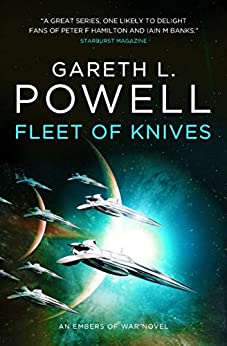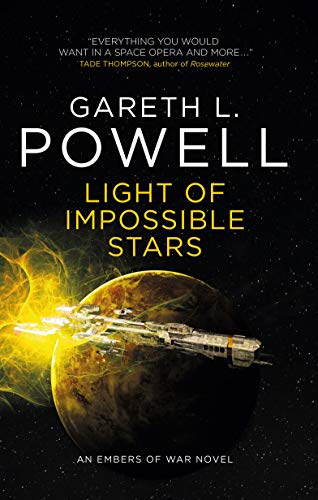It’s no wonder that, in the vastness of space and amid the destruction of planets and whole populations, finding purpose and redemption for past misdeeds should preoccupy so many rootless characters in Gareth L. Powell’s Embers of War series. With his considerable talent Powell combines space opera action with these deeper shades of meaning. It’s an impressive achievement, though at times the redemption and connection characters seek seems to come a bit too easily.
Despite that problem, there is so much to like in these three action-packed novels, Embers of War, Fleet of Knives and Light of Impossible Stars. Powell delivers common scifi tropes in beautiful language with highly original settings and wonderfully imaginative AI characters, including one, the ship Trouble Dog, who steals the show. I want to pick out a few big themes from the three books in this series that have been published so far, rather than attempt a conventional review of them.
Purpose and Redemption
Finding purpose in life and redemption for past crimes come up again and again for a group of characters, including Trouble Dog, who have participated in wars and mass slaughter among factions of the diverse human settlements known as the Generality.

In Embers of War, Sal Konstanz, who served in the horrific Archipelago War as a medic, is captain of The Trouble Dog. The ship took part in the genocidal nuking of a sentient planet-wide forest on Pelapatarn in that same conflict. Both quit the military and signed up for the House of Reclamation, a kind of space medical corps, so that they could dedicate themselves to saving lives instead of taking them.
Trouble Dog is an AI with cloned human brain cells at its core, and it has evolved both human emotions and the beginnings of a conscience which forced it to resign from its killing machine life as a combat heavy cruiser in the navy of the Conglomeration. Konstanz, who fought for the other side (the Outward) in the Archipelago War, is descended from the woman who founded the House of Reclamation.

Joining the House may have given the captain and her ship a new purpose, but people still die on their watch, as some of Konstanz’ rescue efforts fail and Trouble Dog is forced to defend itself by killing an old pack-mate, another heavy cruiser called Fenrir.
Konstanz also finds it no easy task to be redeemed after she is forced to take the life of a headstrong ship captain and spends much of her time alone, wrapped in a blanket in the hold, in a state of depression.
I couldn’t help but think of Viktor Frankl, the Holocaust survivor and psychiatrist, whose influential works, especially Man’s Search for Meaning, emphasize the importance of finding a purpose larger than oneself as a way out of mental illness. It struck a chord with me as a former mental health blogger, always alert to the ways science fiction writers deal with inner turmoil. Konstanz is the main character in these books who really suffers through the discovery of her place in the scheme of things. Many others get there at less cost, and so their struggles seem a little thin.
Becoming Human
Some of the most interesting transformations take place within the minds of the ship AI’s. As Lucy, a construct embodying the mind of a merchant ship destroyed in Fleet of Knives, puts it:
“We’re all human, in some shape or form. Don’t let yourself get so hung up on the hardware; it’s the software that counts.”
Light of Impossible Stars, Kindle location 1367

Trouble Dog often expresses her humanness through her multiple avatars. They range from a pale character in a dark trench coat on a windswept moor to a silken clad goddess with a glistening sword. This is a wonderful way of projecting her moods and varied personalities that suit the moment.
Her characters are not only visible on a screen for communication with the human crew, they seem able to create their own virtual space when in contact with another ship. Strangely, these ship intelligences and their sufferings sometimes seem truer than those of the human characters.
While the AI Lucy, who takes on the human form of a young girl, though her mind is an ancient one, has no trouble accepting emotions, Trouble Dog struggles each time she has a new emotional experience. She is surprised, for example, by a sudden rush of feeling for her former comrade in arms, the heavy cruiser Adalwolf, who seeks a new identity by changing his name to Penitence. She feels a surge of emotion, blurts out, “I love you, you idiot.” and embraces him, though the action seems strange to them both.
Memory and Identity
Many of the characters in all three books struggle with the past. Some have set aside memories of war and atrocity in a deliberate effort to transform their lives. That is especially true of Ona Sudak, the former Annelida Deal, responsible for the extermination of the sentient forest planet Pelapatarn. She not only changed her name but changed her appearance and identity completely, becoming a celebrated poet. But rather than seek redemption she seems more intent, at least early on, in escaping the consequences of her actions.
It is only after she is rescued from a firing squad in Fleet of Knives and given the command of a long dormant fleet of a million warships that she sees herself as gifted with an important purpose that can redeem her past actions. That purpose is to eradicate violence from the universe.
It’s true in a different way of Cordelia Pa in Light of Impossible Stars. She has never really known much about her past, except that she and her brother had been abandoned by their father. But when the father reappears in her life, he is a much different person than she had imagined and gives her a whole new purpose and identity. He poses questions raised throughout the series when he talks about memory:
“They say we’re the sum of our memories, Cordelia. But what happens when we forget?” … When our memories are lost or taken from us, what remains? When we lose the things that make us who we are, who do we then become?”
One of his gifts to her, which she is reluctant to accept at first, is a block of his memories that will turn her into an expert pilot of the ship he also gives her, the Gigolo Aunt. But she starts remembering more than simple piloting methods and wonders how much of what she is remembering now is her own past or her father’s.
The Gigolo Aunt will not only become her home but also be the initial means for getting Cordelia to fulfill her new mission in life, to take her crew through the Intrusion.
Settings
The Intrusion is one element of the many intriguing settings of these novels. It is a mysterious region where two realities meet. No one can explain it exactly. The forerunner race called the Hearthers seem to have created it as a means of escape from this universe. We don’t learn in this series so far where they have gone, but that is the likely subject of a next book. Light of Impossible Stars ends with Cordelia Pa piloting a rather fantastic set of worlds called the Plates, where she grew up, into that unknown region.
The Plates are a set of 20 flat world-lets with different environments, all protected by an energy envelope that preserves breathable air for the human inhabitants. One step in Cordelia’s mission is to find a key that will start up the Plates, which turn out to be a single space ship that can get through the Intrusion.
This universe has a hypervoid, an unusual region of “abyssal space” through which ships can jump to distant locations. Humans can’t stare at it for too long because they tend to see patterns of fantastical beasts. In Fleet of Knives, we discover that those creatures are not so fantastical, and that brings out another trope that Powell handles well: the strange landscape that turns out to be more than it seems.
Just as the Plates appeared to be only environments for human settlement and the hypervoid only a means of transportation, the Gallery, a region of sculpturally carved shapes visited as a tourist attraction, turns out to contain vast spaces that defy the laws of physics. Their surface conceals a small star surrounded by a million dormant space ships who come to life after recognizing in Trouble Dog and the House of Reclamation the legacy of their founding race of beings.
Sequence of Action
The three novels of the series thus far comprise a fairly well plotted sequence of action. Though each probably can be read on its own (there are plenty of fairly skillful backward looking summaries in Fleet of Knives and Light of Impossible Stars), I would recommend starting with Embers of War and reading straight through all three.
Each one introduces new characters and fresh developments to build interest but also prepares the way for the next in the series. Fleet of Knives is the one that bogged me down somewhat, with a long diversion inside a wrecked ship shaped like an asteroid. The stranded crew of another ship are pursued there by vicious beasts and have to wander around endless caverns for far too long, for my taste.
This takes place while the titular fleet of a million warships is interpreting its mission to suppress all violence in a berserker fashion by wiping out any war-making capability of humans and much of humanity itself. More attention to that disaster would have added a lot to this middle volume.
But I still recommend the series highly. One of its many pleasures is the supple and often beautiful narrative language Powell commands. Whether he is describing landscapes, complex action or projected imagery, he sets a fine rhythm and evocative setting to enhance the dramatic shifts his characters go through. I’ll conclude with one small sample:
The screen behind me displayed a stock image of the Intrusion. Spiral arms of glowing gas streamed from its irregular, constantly shjifting edges. At the centre lay a rip in the skein of the universe, a hole through which could be glimpsed the distorted, ethereal light of impossible stars.
Light of Impossible Stars, Kindle location 2411



Leave a Reply